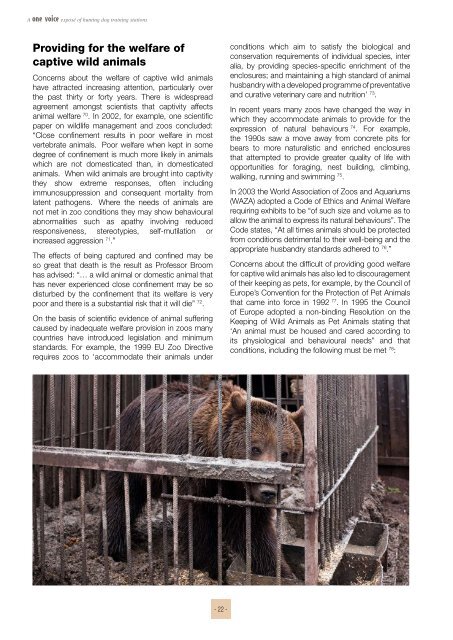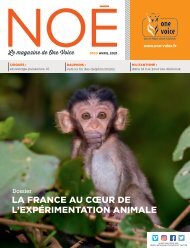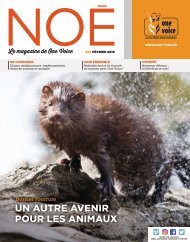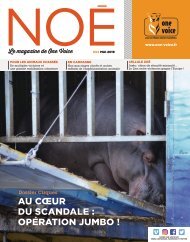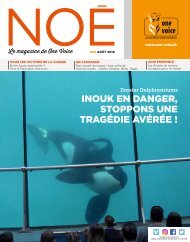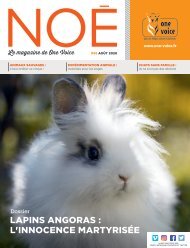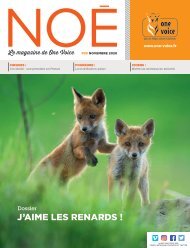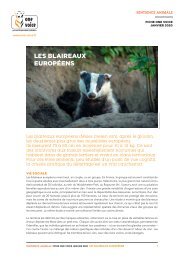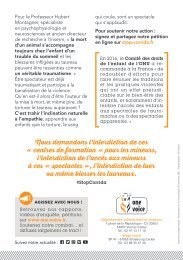The baiting of wild animals in Russia
You also want an ePaper? Increase the reach of your titles
YUMPU automatically turns print PDFs into web optimized ePapers that Google loves.
A<br />
exposé <strong>of</strong> hunt<strong>in</strong>g dog tra<strong>in</strong><strong>in</strong>g stations<br />
Provid<strong>in</strong>g for the welfare <strong>of</strong><br />
captive <strong>wild</strong> <strong>animals</strong><br />
Concerns about the welfare <strong>of</strong> captive <strong>wild</strong> <strong>animals</strong><br />
have attracted <strong>in</strong>creas<strong>in</strong>g attention, particularly over<br />
the past thirty or forty years. <strong>The</strong>re is widespread<br />
agreement amongst scientists that captivity affects<br />
animal welfare 70 . In 2002, for example, one scientific<br />
paper on <strong>wild</strong>life management and zoos concluded:<br />
“Close conf<strong>in</strong>ement results <strong>in</strong> poor welfare <strong>in</strong> most<br />
vertebrate <strong>animals</strong>. Poor welfare when kept <strong>in</strong> some<br />
degree <strong>of</strong> conf<strong>in</strong>ement is much more likely <strong>in</strong> <strong>animals</strong><br />
which are not domesticated than, <strong>in</strong> domesticated<br />
<strong>animals</strong>. When <strong>wild</strong> <strong>animals</strong> are brought <strong>in</strong>to captivity<br />
they show extreme responses, <strong>of</strong>ten <strong>in</strong>clud<strong>in</strong>g<br />
immunosuppression and consequent mortality from<br />
latent pathogens. Where the needs <strong>of</strong> <strong>animals</strong> are<br />
not met <strong>in</strong> zoo conditions they may show behavioural<br />
abnormalities such as apathy <strong>in</strong>volv<strong>in</strong>g reduced<br />
responsiveness, stereotypies, self-mutilation or<br />
<strong>in</strong>creased aggression 71 .”<br />
<strong>The</strong> effects <strong>of</strong> be<strong>in</strong>g captured and conf<strong>in</strong>ed may be<br />
so great that death is the result as Pr<strong>of</strong>essor Broom<br />
has advised: “… a <strong>wild</strong> animal or domestic animal that<br />
has never experienced close conf<strong>in</strong>ement may be so<br />
disturbed by the conf<strong>in</strong>ement that its welfare is very<br />
poor and there is a substantial risk that it will die” 72 .<br />
On the basis <strong>of</strong> scientific evidence <strong>of</strong> animal suffer<strong>in</strong>g<br />
caused by <strong>in</strong>adequate welfare provision <strong>in</strong> zoos many<br />
countries have <strong>in</strong>troduced legislation and m<strong>in</strong>imum<br />
standards. For example, the 1999 EU Zoo Directive<br />
requires zoos to ‘accommodate their <strong>animals</strong> under<br />
conditions which aim to satisfy the biological and<br />
conservation requirements <strong>of</strong> <strong>in</strong>dividual species, <strong>in</strong>ter<br />
alia, by provid<strong>in</strong>g species-specific enrichment <strong>of</strong> the<br />
enclosures; and ma<strong>in</strong>ta<strong>in</strong><strong>in</strong>g a high standard <strong>of</strong> animal<br />
husbandry with a developed programme <strong>of</strong> preventative<br />
and curative veter<strong>in</strong>ary care and nutrition’ 73 .<br />
In recent years many zoos have changed the way <strong>in</strong><br />
which they accommodate <strong>animals</strong> to provide for the<br />
expression <strong>of</strong> natural behaviours 74 . For example,<br />
the 1990s saw a move away from concrete pits for<br />
bears to more naturalistic and enriched enclosures<br />
that attempted to provide greater quality <strong>of</strong> life with<br />
opportunities for forag<strong>in</strong>g, nest build<strong>in</strong>g, climb<strong>in</strong>g,<br />
walk<strong>in</strong>g, runn<strong>in</strong>g and swimm<strong>in</strong>g 75 .<br />
In 2003 the World Association <strong>of</strong> Zoos and Aquariums<br />
(WAZA) adopted a Code <strong>of</strong> Ethics and Animal Welfare<br />
requir<strong>in</strong>g exhibits to be “<strong>of</strong> such size and volume as to<br />
allow the animal to express its natural behaviours”. <strong>The</strong><br />
Code states, “At all times <strong>animals</strong> should be protected<br />
from conditions detrimental to their well-be<strong>in</strong>g and the<br />
appropriate husbandry standards adhered to 76 .”<br />
Concerns about the difficult <strong>of</strong> provid<strong>in</strong>g good welfare<br />
for captive <strong>wild</strong> <strong>animals</strong> has also led to discouragement<br />
<strong>of</strong> their keep<strong>in</strong>g as pets, for example, by the Council <strong>of</strong><br />
Europe’s Convention for the Protection <strong>of</strong> Pet Animals<br />
that came <strong>in</strong>to force <strong>in</strong> 1992 77 . In 1995 the Council<br />
<strong>of</strong> Europe adopted a non-b<strong>in</strong>d<strong>in</strong>g Resolution on the<br />
Keep<strong>in</strong>g <strong>of</strong> Wild Animals as Pet Animals stat<strong>in</strong>g that<br />
‘An animal must be housed and cared accord<strong>in</strong>g to<br />
its physiological and behavioural needs” and that<br />
conditions, <strong>in</strong>clud<strong>in</strong>g the follow<strong>in</strong>g must be met 78 :<br />
- 22 -


